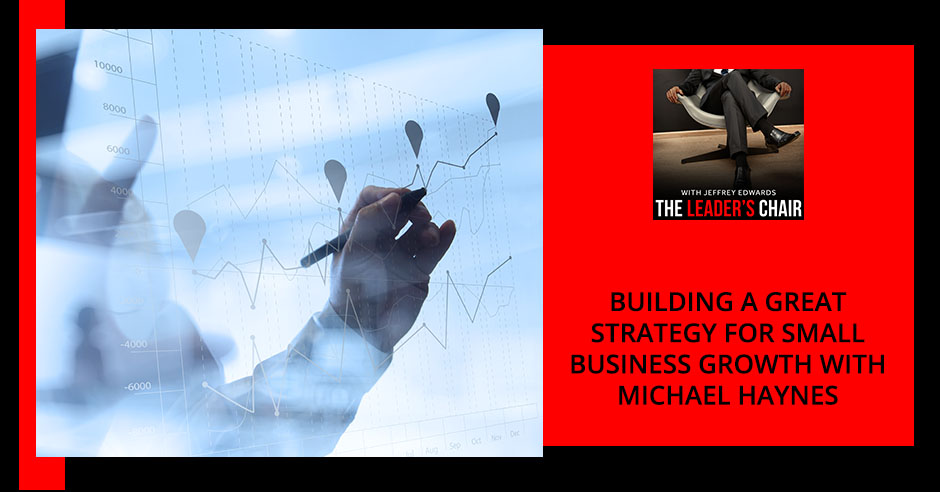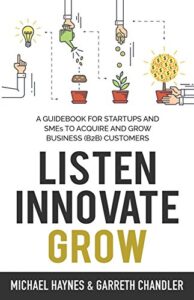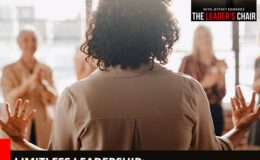
The world of business is changing rapidly. And for small businesses to survive and thrive, they need a growth strategy. Luckily, our guest has just what small and medium businesses need. In this episode, Jeffrey Edwards is joined by business growth strategist and founder of Listen Innovate Grow, Michael Haynes, as they talk strategy for b2b growth. Michael shares his story of how he got into the consulting space as well as his work process and insights on growth strategies. Listen in and learn more from this special episode.
—
Listen to the podcast here
Building A Great Strategy For Small Business Growth With Michael Haynes
It’s wonderful to have you here. Our topic is about strategy. Whether you’re a for-profit or not-for-profit organization, whether you’re a large corporation, whether you’re a small enterprise and you’re getting off the ground, everyone has to have a strategy. What becomes important for any organization over its time is how well can you demonstrate your ability to execute that strategy? What’s the vision for yourself and your organization’s stakeholders?
Our guest is someone who has had the experience of working with global leaders in helping them position their companies, themselves and their employees for long-term success. He is passionate about what he does. Not only does he bring the intelligence and experience of his years in working with executives and small or medium-size corporations and organizations around the world, but he also brings that personal experience in having worked in organizations and seeing the mechanics of what you need to do, but also the mindset that supports a growth strategy for the long-term.

Listen, Innovate, Grow: A Guidebook for Startups and Small Businesses Looking to Acquire and Grow Business Customers
It’s a pleasure to introduce to you our guest, Michael Haynes. He is a small business growth specialist and a principal consultant of a consulting firm, Listen, Innovate, Grow for business to business transactions, build their client base, and achieve the growth that they seek. He is the author of the book, Listen, Innovate, Grow: A Guidebook for Startups and SMEs to Acquire and Grow Business (B2B) Customers. He’s originally from Toronto, Canada but he is joining us from his home in Sydney, Australia. It’s a pleasure to bring onboard our guests, Mr. Michael Haynes. How are you doing, Michael?
Thank you, Jeffrey. It’s great to be here and have this discussion with you. That’s quite the intro. I’m most impressed. I don’t know if I’ll live up to all of that, but I’m going to do my best to inspire and educate your readers in our conversation. Thank you for having me. It’s great to be here.
It’s wonderful to have you here, Michael. I’ve had the opportunity to engage with you and we’ve had our conversations in the groups that we belong to. There always seems to be this passion around strategy and around mindset and growth. What we’ve witnessed over our careers and in the work we do is how some companies seem to get it and how a number of companies seem to struggle with the concept around create a strategy. What does that look like? What’s vision and what does that mean in terms of short-term and long-term growth? I’m curious from your perspective, what is it that drove you to this area of specialty as part of your career path?
As you mentioned in that fantastic introduction, my focus is working with small and medium organizations on how they acquire, retain and grow those larger business customers in that B2B context. How I got here has been quite a journey. I started off my career in big corporate. My whole focus has always been around working with organizations on how to make them truly customer-centric. It’s not just writing these vision statements and writing these massive strategy documents, but how do we translate that into execution that customers are going to feel the experience, which is going to make them want to buy from you, stay with you, and refer the business to you.
I did that in the corporate world. I always had an interest in entrepreneurship, having my own business. My sister has her own law practice in Toronto. My cousin and her husband had their own businesses. I’ve always been surrounded by entrepreneurs. I’ve always felt that the SMEs were my people. In 2010, I decided to leave the corporate and take the skills and knowledge that I’ve acquired in big corporate and wanted to show and help small-medium organizations on how they can succeed in B2B.
That’s my passion because I truly believe that if you know how to navigate the B2B space and you understand it, it’s the way in which we can empower SME leaders to build the businesses and lives that they seek. That’s where lots of opportunities lie. Even in this crazy new norm world that we’re in, B2B is still massive. It’s about me focusing and seeing great organizations and great people who are good at working in the business and helping them to know how to work on the business to go to their full potential, and achieve what they want to achieve through B2B. That’s how I got there.
The B2B space is the way in which we can empower SME leaders to build the businesses and lives that they seek. Share on XIt sounds like it’s the integration of the family experiences and people in your life that you’ve been to be part of your worldview, as well as your professional experience in large corporations that you’re bringing together to impart that knowledge, wisdom and helping others achieve the same results.
It’s been both the personal and the professional that has enabled, motivated and driven me to focus on people that I truly relate to and want to see succeed, which are your current SME, leaders, owners, and also those that are aspiring to be. I’m wanting to help them how they can achieve the impact and success goals that they want to achieve and do so through B2B. I believe that is the way you can do it. There are lots of opportunities to build, grow and scale your business. That growth on all levels both professionally and personally can be achieved by B2B.
What’s the process that you walk a CEO through when they hire you to work with them? Paint a picture of what that would look like for someone who was thinking about, “How am I going to grow? What can you do to grow my business? What’s my next step in creating a strategy for my business?”
To give you an example, I was working with a couple of service institutes and service organizations with a new CEO. She wanted to take the business to the next level. She had some ideas of what she wanted to do but wasn’t quite sure. Typically, I will start having a couple of meetings and deep-dive sessions with the CEO and probably other members of their leadership team to understand where they’re at. What are they looking to achieve? What have they tried? What are some of the barriers?
I’m trying to get a strong understanding of the business and what they’re trying to achieve, their capabilities, and where they had wins and successes. A lot of that which is part of my overall approach is about listening to you as the business owner and the senior management team to get an understanding of where they’re at currently. That’s step one. Step two is to try to get an understanding of who are they currently serving. It’s getting an understanding of their current client customer base. What are they like? Where are they having these successes? What do they know about? Where are those clients and customers? Where are those decision-makers and buyers? That’s a key distinction point about B2B.
What understanding do you have and some of your insights at a buyer level of those decision-makers in those current clients and customers, or those key strategic clients that you want to get who are integral to growing your business? Understanding where those gaps are, and then that will give us a start to give us a roadmap of where they’re looking to go and the needs of their clients? It’ll start to help us frame what the roadmap has to be, needs to be or should be. If there are gaps in the understanding around clients and the decision-maker with there often is, then we need to look to fill those gaps so that we have a robust understanding, so that we can put together a strategy and an action plan that will make sense to move the business forward.
In listening to you, I have picked up some of the key components of strategic planning. If you’re going online, you can Google a lot of different models and different plans that can move people through those stages. The key element that’s missing from our organizations is understanding the why behind everything. For you, what do you find the top issues or the barriers that these CEOs have to work through in order to reach that level of understanding and confidence that their business is positioned to grow or at the end, there’s a potential that they can grow their business for the long-term?
There are a lot of uncertainties as to how to take their businesses forward. Part of that stems from the fact that there’s not enough listening that has to be done. Listening has to be done on three levels. Listening to you, as I talked about, is having an understanding of you as the business owner and the senior management team. Having an understanding of your goals and objectives, and where you’re looking to go.
Listening to you as you’re taking a look at your business. Understanding, what are your strengths? Where are you winning? Are there certain industries, markets and clients that you’re having success in? What products and services are you having great success with in terms of your financials and getting those referrals, etc.? Knowing where you want to go and having that depth of understanding, but then also have an understanding in terms of those current industries and geographic markets that you’re serving.
Having a depth of understanding of what’s going on there. What are the trends? What are the developments? What are some of those broad customer needs and requirements? What’s changed and what’s happening? Having a pulse of what’s going on in those target industries and markets. It’s very important because lots of things are changing. It’s important that you have that depth of understanding at that level. It also comes to having an understanding of your customers, the customers you are currently serving. Those that you want to serve and have an in-depth understanding, not just at an organizational level to say that you understand.
Let’s say you’re an IT firm and you’re targeting Air Canada. It’s not enough to understand the goals of what Air Canada is trying to do, but you need to understand the specific services that you offer. Let’s say it’s around cyber security or providing IT strategy. It’s knowing who are the decision-makers within the Air Canada organization. Who is responsible for those parts of the decisions? Do you understand their motivations, drivers, priorities, and how they make purchase decisions? It’s important that you get that depth of understanding and a current level of understanding of that. That will tell you where you need to focus and what you’re going to need to be delivering to those current clients and or prospective clients in order to take the business forward.
Listening on those three levels, listening to you, listening to the market, listening at a customer/buyer level is critical. It’s the area that I find the most important piece because it sets the framework to move forward, but that’s where there are often lots of gaps in terms of what I’m dealing with large corporations or when I’m focusing on dealing with a small medium-sized company. That’s where there is not enough depth of understanding across those three levels. Often, that’s the starting point where there are gaps that we need to fill to have a detailed and robust understanding of what needs to be put in place.

Small Business Strategy: Small and medium-size organizations have limited resources and budgets. We have to focus on what’s going to give us the biggest bang for the buck.
In your role as that advisor or a consultant, how do you help them bridge those gaps in understanding and the awareness of the markets that ran in and what their value proposition is going to be to that prospective client?
Typically, what I’ll be doing is I will be working with the organization. I will often have some workshops and there will be some preparation for those workshops. There will be some deep-dive meetings with the senior management team around that listening to understand where they’re at and where they’re looking to go. Let’s get an understanding of their strengths of how the business is performing. That might require them getting some of their folks and finance, etc. to be pulling some of the required data, so we can have a discussion and be understanding where are the opportunities? What are the areas of strength?
Similarly, we’ll conduct some other workshops often around that listening so we can do a bit of an audit to understand who are your current top ten clients that are counting the core of your 80% of your revenue, that 80/20 rule. Let’s take a look at what do we know about them. Often we’ll have a bit of a workshop to understand what we know about them currently, what we’re looking to hopefully do with them, and identify where are those gaps. Let’s put some listening mechanisms in place. It could be around doing a workshop with those clients. It could be depth interviews. It could be around setting up customer forums, depending on what we’re looking to do.
We’ll put some listening mechanisms in place to build our understanding that we need to be getting at that decision-maker level and doing series of workshops around that. Often, there will be action planning sessions that I’ll have with them as well. As we’re getting some of that data analysis, we might do additional workshops to say, “What’s the so what?” What does it mean for the business? Having some action plans to identify what are going to be the priorities in terms of key initiatives and what we’re going to be working on.
Is it developing some new product offerings or some new client engagement programs? We’ll have action planning sessions to scope out what are going to be the priority activities. Small and medium-sized organizations, in particular, have limited resources and budgets. We have to focus on what’s going to give us the biggest bang for the buck. Doing a lot of action planning sessions where we put together those action plans that are going to state what are going to be the top 3 or 4 initiatives and what are some of the action steps to get those off the ground?
It's not enough to understand the goals of what the business is trying, but you need to understand the specific services that you offer. Share on XAnyone can write a strategy but I strongly believe that it’s when you’re going through these workshopping and action planning sessions where we’re getting into the detail where I’m working with them. I’m not doing the work for them but I’m involved in the session and guiding so we can come out at the end of the meeting to say, “Your priorities are going to be developing a new comprehensive IT solution for these target customers.” We’re going to do a customer forum for your top ten customers. It can be an interactive dialogue session and we’re going to implement a program of having quarterly reviews with your top three customers. I’m going to say those are the three initiatives as an example.
We’ll work through those key initiatives, what are the action steps? Who needs to be engaged so that the organization has some very clear steps as to, “We’re developing a new solution. Who needs to be engaged from products, operations, frontline staff, learning and support? What needs to happen? We need to have a kickoff meeting. We need to have a workshop.”
It’s helping them get to that granular and actionable level because that’s when the traction, that’s when you get momentum and things actually happen. Anyone can put together a nice PowerPoint document that talks about it at a high level. We should develop a product strategy. We should develop a new client engagement. I believe in taking everything to an actual level of detail, almost like a recipe book so you know what exactly needs to be done. That’s when you start seeing what are the implications and how do we actually execute. The issues come to the fore and you can start working through those issues.
People outside of the management consulting stream and management circles can appreciate the amount of time and energy that’s put into planning a path for an organization. Part of the challenge too is while you do all this work with leadership teams and subject matters experts in putting that plan together, we talked about the leadership team. It points towards more of the mindset around that. How do you bridge that gap between, “This is where I want to go,” but also helping to instill the belief that it’s possible to actually get there? Where are the supports that you find are helpful along the way to sustain that level of belief and that level of energy and commitment to achieving that goal?
In terms of the growth mindset, there are a couple of things. I’m a big believer in practicing what I preach. In terms of a growth mindset, I love to workout and exercise every day to keep in shape. You have to work on your growth mindset regularly and consistently every day. I personally believe that’s important more so than ever in this environment of volatility and uncertainty. Here in Australia, we’re in lockdown, open up and shut. When I’m trying to take my own business forward, working with other SMEs moving forward, you have to work on that. I do a lot of reading and listening to podcasts, where I can get a lot of motivation and guides to help me keep on my game and to help keep me in the zone.
The two books that I’m reading right now in tandem are The Art of the Possible by Rob Hartnett and Velocity Mindset by Ron Karr. I’m in chapter two of those. I read each and every day to help keep me in the zone as I’m working on my own business and I’m coming to roadblocks and I’m trying to take things forward. Doing that and listening to various podcasts as well. I listen to the Coaches Corner by Lucas Rubix and another podcast like Manifest Yourself. I’m constantly listening to podcasts and reading. That’s one element and that’s something I encourage all my fellow CEO and SME peers to be doing. Also, being part of communities and relevant groups where you can have that collective wisdom, sharing, learning and inspiring each other.
Jeffrey, you and I are members of certain groups. I’m in something I’m quite big on. I have set up a mastermind group for fellow SME CEO leaders to give them that opportunity where they can learn, share experiences, brainstorm and those with common goals of being SME CEO looking to grow through B2B. I’m a member of various groups. You and I are members of a couple of them. I encourage leaders to do so. I’ve created that SME mastermind group, which I called Empower because you need to be getting ideas, insights and inspiration, that collective thinking. I think it’s a bit of self-education combined with being a part of that mentorship, that peer-to-peer group is something that I am practicing and I’m doing. I’m also encouraging SME leaders to do that as well and also providing them with the means to do so through The Empower Mastermind Group.
It’s great to hear that you’ve got that program kicking off. I can imagine that the book that you wrote on strategic planning in general and the process that you outlined are themselves two extra tools and resources that the leaders that you support and others as well have access to use as they continue to develop and scale their business for future success.
The book Listen, Innovate, Grow is based on the Listen Innovate Grow framework. It’s your guidebook on how you acquire, retain and grow business customers. I consider it to be an action-oriented book. Strategy is part of it. It covers the three key activities, which are listen, innovate, grow, which are the three activities that all businesses need to be doing on an ongoing basis. My book, which I wrote with my co-author, Garreth Chandler, is a book written for SMEs operating in B2B. It’s very practical and actionable things that they need to do in a very strategic way. Listening, which is all about gaining an in-depth understanding of the three levels. Innovation is about business innovation. People often think about innovation around technology. It’s around features or they’ll think it’s around going digital.

Small Business Strategy: Leaders have to be conscious of what needs to be done from a people and culture perspective because people and culture are your most important asset.
You need to business innovate. If you want to be able to grow and have relevancy with your clients and customer, you have to business innovate. It is about making new introductions and/or improvements in your business across five areas. It could be around your products, services, processes and organizational structure. Are you doing joint ventures and those things? Is it around your marketing strategy for which there are some very specific B2B things you should be doing?
It’s the business innovation. Making those new introductions and improvements in your business based on industry, market, customer and buyer’s need. That’s how you win. That’s how you’re going to be able to have the relevancy and to track those clients that you want, keep the clients that you currently have, and get them spending more to build and scale your business. The growth activity is all about the ways in which are you going to grow. Are you going to go after new markets, customers and offerings? Are you going to be going for market share, pricing increases, combinations thereof, what you call the growth pathways?
It’s also about creating and maintaining that environment within your business for growth. What are you doing to motivate and inspire your people? The whole people element is quite critical. Managing change in your organization. As you’re going from 10 to 15 to 100 people, as you’re moving, growing and bigger, it’s going to cause a change in terms of how your organization operates. There are change management considerations that you need to worry about.
There’s the financial as well in terms of managing your finances. You do have to invest to grow but how do you manage that appropriately? How do you grow profitably? Listen, Innovate, Grow, the book is based on the Listen, Innovate, Grow framework, which are the three key activities that all of us as SMEs and all businesses, but this is particularly written for small and medium-size. This is what we need to do on an ongoing basis to be able to acquire, retain, grow clients and grow our business consistently and profitably.
It seems simple when you layout that way in terms of understanding these phases and areas of focus and attention that will help you move forward. I’m curious when you mentioned the growth side. There’s a business side of it. In terms of the operations and strategy, where are some areas that also accompany the growth of the individual or the leader themselves and what they need to do and continue to grow? You mentioned books and podcasts and that self-investment learning. What other areas would you feel that that person needs to focus on as part of their growth journey as well?
Making those new introductions and improvements in your business based on industry market and customer buyer need is how you win. Share on XFor leaders, we have to be conscious about what needs to be done from a people and culture perspective. People and culture are your most important asset. They are the enablers. I can put together a strategy. I can work with your team to put together a great strategy, to put together the action plans to drive that growth but it’s your people that are ultimately going to be able to execute on it. As senior leaders, you got to get the right talent. In this environment right now, getting the right people for your organization can be a challenge.
Once you get them making conscious efforts on how you’re going to make it an environment that is empowering, inclusive and enables them to be innovative to contribute to their ideas and wanting to do so and being able to do so. Enabling your people to grow and develop in terms of their skills and their experiences. It’s making sure that you’re creating that environment within your company. Part of their growth development as senior leaders are making sure that you’re putting significant focus on that, which might be doing some education courses yourself, but also bring in the necessary people who focus on people and culture because that is so integral.
It’s something that sometimes some leaders often think, “That’s soft feely stuff. It’s all about the numbers. It’s about the strategies and the execution.” Yes, it is but your people are the enabler. It’s critical now because if you want to be innovative and you want to grow, you got to get that diversity of thought and ideas and skills. Having those right people that can be leaders, engaging in building and maintaining client relationships.
You need to be able to get the right people, which is quite important because of the skillsets that are required, both of those hard technical skills but those relationships, client development skills and listening skills. It’s about creating that environment. In addition to the mindset stuff that I’ve talked about and immersing yourself in communities, it’s all to foster ideas, inspiration and problem-solving. I would say leaders need to make sure that they’re putting a focus around that whole people and culture. How to build that culture, maintain that culture, which also means being aware of the changes that are going to undergo in your organization. Trying to get a bit of a sense of what that might involve but rebuilding the knowledge and the resources around to help you manage the change. As you start to scale and grow, that’s how the people in culture can become a bit unstuck. That’s how you can get some traction within the organization.
I have one last question for you, Michael. You’ve done this work for many years. You’ve worked with a number of companies around the world. What have you learned about yourself as a professional? As you build your organization, you continued to grow and scale as well. What insights and wisdom have you gleaned for yourself that has been part of the growth journey that you’ve been on over this path?
I would sum it up in one sentence that you have to invest to grow and you have to back yourself. That’s one thing that I’ve learned. If I go way back to 2010 when I first started as an independent consultant, I had that view. You work for yourself by yourself and I tried to do everything. What I couldn’t do was swept under the table and focus on my strengths. You can’t build the business that way. Even if you want to maintain as a sole practitioner as a micro-business, you cannot maintain a thrive that way. It’s too hard. There are too many things that you have to do. I’ve recognized you have to invest to grow, which means investing in terms of my knowledge, skill and building on my knowledge and skills constantly because things are changing and I need to practice what I preach.
I’m big on listening and knowing what’s going on with my clients, customers, etc. Also, knowing where I need to invest financially in those resources. I know what I’m good at. I know what I’m not good at. For example, all that execution around updating my website, SEO and stuff. That stuff is far too technical. I can’t do it. All that stuff is on Mailchimp, with executing marketing campaigns. Even though I am an advisor and independent sole operator, I have my virtual team.
I have Anna up in Brisbane who does all my marketing stuff. She schedules my social media, does my emails and manages Mailchimp. All that technical stuff, just thinking about it get the hairs on my back going. I recognize that it’s not my strength. I’ve got someone to do that and do that well. For example, content, SEO, website and all that are not my strengths. I’ve got Dan up in the North Coast who manages all of that. It’s recognizing and building my own skillset. Even though I’m an advisor, I have a number of coaches who I work with to keep me on top of my game, developing the skills that I need to develop. Also, to give me that objectivity in terms of growing my business, to have that third party view because you can’t look at your own business. It’s your baby.
I’ve taken Listen, Innovate, Grow from its predecessor Excel Consulting. It has been quite the journey. You need to have that third party who can point out what’s working, what’s not, and what you need to do. You just don’t have that objectivity when it’s something that you’re passionate about building and growing. Knowing what you have to invest to grow and that’s time, effort and money is one of the big learning that I’ve come to.

Small Business Strategy: You have to invest to grow, which means investing in terms of knowledge and skills, and constantly building on them because things are changing, and you need to practice what you preach.
I’ll be honest with you, Jeffrey. It took me a while to come to that. I spent the first couple of years struggling a bit because it’s like, “I can’t spend money to do that.” It was only impacting me in a negative way because certain things were getting done at all and some things weren’t getting done to the level that they needed to be. Making that investment and that commitment has allowed me to have the business move along. I now operate globally. I am an international global operator. I wouldn’t have been able to do so if I had not made those investments in the mentors, coaches and support team I need to be able to execute all the elements of the business that needs to be executed when you’re trying to build a company and a business. You’ve got to invest to grow on those three levels, time, effort and money. You have to be prepared to do all three.
I would add my friend that your mindset.
I work on it every day because it keeps me in the zone. Although I’m generally a very positive person and upbeat, I do have my days where I hit roadblocks. It’s like, “What is going on? How do I move past this?” Listening to those podcasts, reading those books, being a part of communities, such as what you and I are up with David Newman. Those are very important to keep me inspired and motivated. Also, having that velocity and that momentum to keep moving forward and trust the process.
You’ve been awesome. Your wisdom, experience and sharing all these great tips and key strategy points are fundamental for any organization. Any person in that decision-making role and sane strategy to hone and to harness is key for their success. Always thinking long-term about that road to legacy, how do you start that and definitely lay down a pathway for that. If people want to find more about what you’re doing and also access your book, where can we send them in?
The best place to go is my website, ListenInnovateGrow.com and there you’ll see a lot of articles. Go to ListenInnovateGrow.com/blog. There are a lot of podcasts interviews that you can listen to that will give you various insights. In terms of my mastermind group, The Empower SME Mastermind Group for SME leaders in operating B2B.
Go to ListenInnovateGrow.com/mastermind. You’ll see all the details there around the mastermind program, which is a virtual mastermind program aimed at inspiring, educating and helping SME CEO leaders that are operating in the B2B context that are looking to grow. We have cross-industry members and cross geography. It’s about getting that innovative thinking from different perspectives, from different industries, and from different parts of the world for all of us SME leaders who are looking to build and grow. The theme of the group is Empowering SME Leaders Through B2B because that is how you’re going to get the growth impact and the life you seek.
If you want to be innovative and grow, you got to get that diversity of thought, ideas, and skills. Share on XI’m sure if there were people living on the moon, you’d want to bring them into your group as well.
That’s going on here on planet Earth right now.
I’m planting the seed for growth. As you said, you always got to think about growing. I’m putting it out there. Michael, thank you so much and I appreciate you taking the time to spend with us and sharing your knowledge, your wisdom and your expertise in helping small and medium-size organizations focus on and understand what growth is and how to achieve that. You are always welcome here on the show and we look forward to catching up with you down the road as well.
Thank you again, Jeffrey. It’s been a great conversation. I look forward to coming back again in the future.
Thanks again to Michael Haynes for joining us here. Thank you for allowing us to be a part of your day. Until next time, remember, be good and lead well.
Important Links:
- Listen Innovate Grow
- Listen, Innovate, Grow: A Guidebook for Startups and SMEs to Acquire and Grow Business (B2B) Customers
- The Art of the Possible
- Velocity Mindset
- Coaches Corner
- Manifest Yourself
- Empower Mastermind Group
- ListenInnovateGrow.com/blog
- ListenInnovateGrow.com/mastermind
About Michael Haynes
 Michael Haynes is a SMB Business Growth Specialist.
Michael Haynes is a SMB Business Growth Specialist.Love the show? Subscribe, rate, review, and share!
Join The Leader’s Chair Community today:





